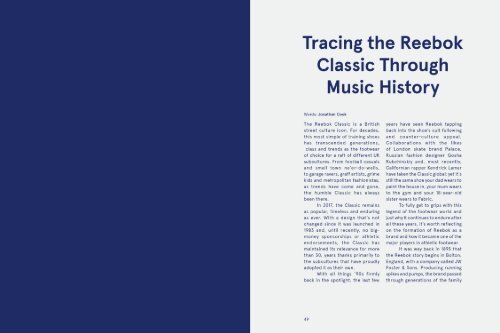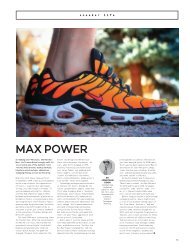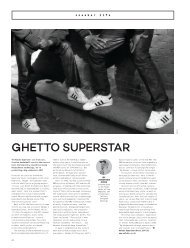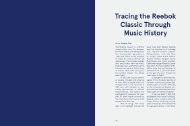Tracing the Reebok Classic Through Music History
Create successful ePaper yourself
Turn your PDF publications into a flip-book with our unique Google optimized e-Paper software.
<strong>Tracing</strong> <strong>the</strong> <strong>Reebok</strong> <strong>Classic</strong> <strong>Through</strong> <strong>Music</strong> <strong>History</strong><br />
<strong>Tracing</strong> <strong>the</strong> <strong>Reebok</strong> <strong>Classic</strong> <strong>Through</strong> <strong>Music</strong> <strong>History</strong><br />
until, in 1958, Jeff and Joe Foster<br />
Jnr formed a companion company,<br />
at first called Mercury Sports.<br />
Unable to legally register that<br />
name, <strong>the</strong> bro<strong>the</strong>rs sought out<br />
<strong>the</strong> aid of <strong>the</strong>ir local patent agent,<br />
who informed <strong>the</strong>m that <strong>the</strong><br />
easiest names to trademark were<br />
<strong>the</strong> most unusual. Joe dug out<br />
<strong>the</strong> 1943 edition of Webster’s<br />
New School and Office Dictionary<br />
that he had won in a running<br />
competition as a boy and found <strong>the</strong><br />
word <strong>Reebok</strong>, meaning ‘antelope’<br />
in Afrikaans – <strong>the</strong> <strong>Reebok</strong> brand<br />
was born.<br />
Then, in 1979, an American<br />
businessman by <strong>the</strong> name of<br />
Paul Fireman bought <strong>the</strong> North<br />
American distribution rights for<br />
<strong>Reebok</strong> and had his team set about<br />
designing new shoes that<br />
would appeal to consumers in<br />
an increasingly crowded,<br />
yet booming, marketplace for<br />
performance footwear.<br />
The first shoe to arrive from<br />
Fireman’s team was <strong>the</strong> Freestyle<br />
in 1982, pitched to appeal to <strong>the</strong><br />
thriving women’s aerobics industry.<br />
Featuring super-soft, garmentgrade<br />
lea<strong>the</strong>r, <strong>the</strong> Freestyle was an<br />
instant success, affordably blurring<br />
fashion and performance like<br />
no o<strong>the</strong>r shoe before it, and opening<br />
up a whole new category for both<br />
<strong>Reebok</strong> and <strong>the</strong> sneaker world.<br />
Buoyed by <strong>the</strong> Freestyle’s<br />
success, in 1983 <strong>the</strong> <strong>Classic</strong> Lea<strong>the</strong>r<br />
was launched. At odds with <strong>the</strong><br />
performance shoe market’s shift<br />
to nylon and suede uppers and<br />
constructions at <strong>the</strong> time, <strong>the</strong> <strong>Classic</strong><br />
borrowed <strong>the</strong> soft garment lea<strong>the</strong>r<br />
from <strong>the</strong> Freestyle to create <strong>the</strong> style<br />
conscious, unisex running shoe that<br />
we all now know so well. Rumour has<br />
it that <strong>the</strong> use of garment lea<strong>the</strong>r<br />
was, in fact, a mistake and little<br />
more than <strong>the</strong> result of an incorrect<br />
materials order. Erroneous or not,<br />
<strong>Reebok</strong> went with it, taking a risk<br />
that continues to pay off to this day.<br />
One very much premeditated<br />
aspect of <strong>the</strong> <strong>Classic</strong>’s design<br />
though, was <strong>the</strong> Union Jack logo<br />
on <strong>the</strong> shoe’s side, incorporated by<br />
Fireman to give <strong>the</strong> shoe a strong<br />
identity in <strong>the</strong> American market.<br />
Pushed aside as <strong>Reebok</strong>’s main<br />
logo by <strong>the</strong> now famous vector logo<br />
in 1992, <strong>the</strong> Union Jack has stood<br />
firm on <strong>the</strong> <strong>Classic</strong> throughout its<br />
34-year history – and it’s this small<br />
detail that has helped endear <strong>the</strong> shoe<br />
to generations of Brits, keen to<br />
eschew American or European brands<br />
for a proud touch of patriotism and<br />
heritage.<br />
As <strong>the</strong> 1980s rolled on,<br />
<strong>the</strong> sneaker industry focused<br />
increasingly on flashy gimmicks,<br />
celebrity endorsements and wild<br />
neon colours. <strong>Reebok</strong>’s downplayed<br />
garment lea<strong>the</strong>r range of shoes fell<br />
out of <strong>the</strong> spotlight, and over <strong>the</strong><br />
years ahead it would be <strong>the</strong><br />
responsibility of a handful of<br />
subcultures to keep <strong>the</strong> <strong>Classic</strong><br />
alive.From here, <strong>the</strong> shoe became<br />
synonymous with British football<br />
casuals culture and could be seen on<br />
terraces and pub pavements across<br />
<strong>the</strong> UK. The tough, no nonsense –<br />
yet supremely stylish – casuals look<br />
and movement helped establish<br />
<strong>the</strong> <strong>Classic</strong>’s street level credentials<br />
for generations to come.<br />
But it wasn’t just in <strong>the</strong> UK<br />
that <strong>the</strong> shoe was finding popularity<br />
among those from <strong>the</strong> wrong side<br />
of <strong>the</strong> tracks. In Harlem hustler<br />
50 51
<strong>Tracing</strong> <strong>the</strong> <strong>Reebok</strong> <strong>Classic</strong> <strong>Through</strong> <strong>Music</strong> <strong>History</strong><br />
<strong>Tracing</strong> <strong>the</strong> <strong>Reebok</strong> <strong>Classic</strong> <strong>Through</strong> <strong>Music</strong> <strong>History</strong><br />
Azie Faison’s memoirs ‘Game<br />
Over’, <strong>the</strong> author sings <strong>the</strong> praises<br />
of <strong>the</strong> <strong>Reebok</strong> <strong>Classic</strong> and tells of<br />
<strong>the</strong> popularity of <strong>the</strong> white-onwhites<br />
on 1980s New York’s streets.<br />
Indeed, legend has it that when<br />
infamous Mafia boss John Gotti<br />
surrendered to <strong>the</strong> police, he did<br />
so in a pair of white <strong>Classic</strong>s.<br />
Back in <strong>the</strong> UK, <strong>the</strong> shoe<br />
maintained its street champion<br />
status as <strong>the</strong> acid house and<br />
hardcore rave movements swept<br />
<strong>the</strong> country. Without <strong>the</strong><br />
extortionate price tag attached<br />
to most trainers of <strong>the</strong> time,<br />
<strong>the</strong> <strong>Classic</strong> was a shoe you<br />
could rave in comfortably<br />
without worrying about what you<br />
trod in, or who trod on <strong>the</strong>m.<br />
When hardcore turned<br />
to jungle and <strong>the</strong>n to UK garage<br />
in <strong>the</strong> early and mid ‘90s,<br />
<strong>the</strong> <strong>Classic</strong> was re-appropriated<br />
once more, with <strong>the</strong> Moschino<br />
and Versace-clad ravers of <strong>the</strong><br />
time pairing <strong>the</strong>ir insanely loud<br />
Italian designer garms with <strong>the</strong><br />
simplicity and Britishness of <strong>the</strong> alllea<strong>the</strong>r<br />
shoe.<br />
Londoner MC Bushkin, from <strong>the</strong><br />
legendary garage collective Heartless<br />
Crew, was one of <strong>the</strong> key exponents<br />
of this look, rocking thousands of<br />
pounds worth of designer labels with<br />
£50 <strong>Reebok</strong>s. He remembers <strong>the</strong> era<br />
well and, to this day, still wears his<br />
<strong>Classic</strong>s with pride.<br />
“In <strong>the</strong> early ‘90s, fashion<br />
in London was really influenced<br />
by America or Jamaica; big baggy<br />
jeans and bulky boots and trainers,”<br />
he explains. “Things changed<br />
when jungle and garage took over;<br />
<strong>the</strong> fashion changed. That music was<br />
something we created and could call<br />
our own. It was us, it represented<br />
our own style.<br />
“Baggy jeans were out; it was<br />
all about straight jeans. <strong>Classic</strong>s are<br />
smooth, so <strong>the</strong>y fitted <strong>the</strong> straight<br />
jean look. They’re not overdone,<br />
not too hype; <strong>the</strong>y’re just smooth and<br />
fitting. White boys had that swagger<br />
from early; straight jeans and <strong>the</strong><br />
<strong>Classic</strong>s. The two go hand-in-hand;<br />
<strong>the</strong>y’re a perfect marriage.”<br />
By <strong>the</strong> Millennium, <strong>the</strong> jungle<br />
and garage scenes and <strong>the</strong>ir<br />
associated looks had long faded<br />
away, but <strong>the</strong> <strong>Classic</strong> remained as<br />
popular as ever with <strong>the</strong> British<br />
working classes – with it regularly<br />
cited as <strong>the</strong> most commonly found<br />
footprint at UK crime scenes.<br />
However, as retro shoes began<br />
to dominate <strong>the</strong> marketplace,<br />
<strong>the</strong> shoe found new fans drawn in<br />
by its throwback appeal and <strong>the</strong><br />
simple, go-with-anything design that<br />
befitted its name.<br />
As photographer Ewen Spencer<br />
(famed for his snaps from <strong>the</strong> heyday<br />
of <strong>the</strong> ‘90s UK garage scene) reflects,<br />
it’s <strong>the</strong> au<strong>the</strong>nticity of <strong>the</strong> era that<br />
<strong>Classic</strong>s have come to represent<br />
that has ensured <strong>the</strong>ir continued<br />
popularity in <strong>the</strong> years since:<br />
“I think <strong>the</strong>y’re still relevant<br />
because <strong>the</strong>re’s an au<strong>the</strong>nticity to<br />
<strong>the</strong>m that doesn’t exist now in <strong>the</strong><br />
same way it did in <strong>the</strong> ‘90s. People are<br />
searching for something with those<br />
connotations; a ‘90s casual, working<br />
class or rude boy culture.<br />
“When you think about<br />
movements like garage and jungle,<br />
it’s difficult to find that sort of<br />
spontaneity and subculture now,<br />
so people go hunting for it in<br />
<strong>the</strong> past. I guess all styles are<br />
cyclical and get re-appropriated,<br />
and that’s what’s happened with <strong>the</strong><br />
<strong>Reebok</strong> <strong>Classic</strong>.”<br />
And as <strong>the</strong> second decade of<br />
<strong>the</strong> century has progressed, that<br />
re-appropriation has continued<br />
apace, with <strong>the</strong> <strong>Classic</strong>’s ‘90s<br />
credentials seized on by a generation<br />
looking to reclaim <strong>the</strong> style and<br />
attitude of <strong>the</strong> decade of <strong>the</strong>ir<br />
birth. The cult success of London<br />
anti-fashion label Sports Banger,<br />
which famously subverts <strong>the</strong> <strong>Reebok</strong><br />
logo in many of its most iconic<br />
designs, bears testament to <strong>the</strong> new<br />
found hype behind <strong>the</strong> <strong>Classic</strong> brand<br />
and <strong>the</strong> culture it represents.<br />
As Sports Banger’s chief<br />
protagonist Johnny Banger says of<br />
<strong>the</strong> shoe that has inspired so much<br />
of what he does:“<strong>Reebok</strong> <strong>Classic</strong>s<br />
were foretold. If you’re going to call<br />
it a <strong>Classic</strong>, you better make sure it<br />
is a classic.” We couldn’t have put it<br />
better ourselves.<br />
52 53






